The Mobile Printer Market is estimated to be valued at USD 1.4 billion in 2025 and is projected to reach USD 2.9 billion by 2035, registering a compound annual growth rate (CAGR) of 7.7% over the forecast period.
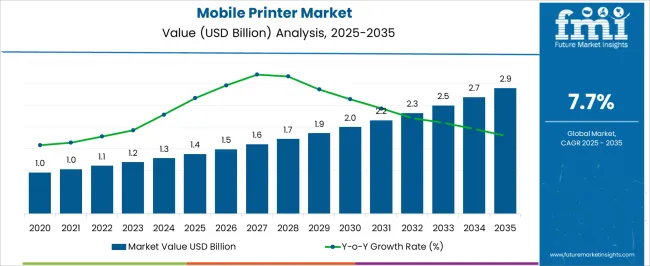
| Metric | Value |
|---|---|
| Mobile Printer Market Estimated Value in (2025 E) | USD 1.4 billion |
| Mobile Printer Market Forecast Value in (2035 F) | USD 2.9 billion |
| Forecast CAGR (2025 to 2035) | 7.7% |
The mobile printer market is experiencing notable growth as organizations and consumers increasingly prioritize portability, convenience, and on-demand printing capabilities. The shift toward digital workflows has accelerated the adoption of compact devices that can integrate seamlessly with smartphones, tablets, and wireless systems, enabling efficient printing in diverse environments. Market expansion is further supported by advancements in connectivity, particularly Bluetooth and Wi-Fi, which allow fast and secure transfer of print data without reliance on traditional wired infrastructure.
Increasing applications across retail, logistics, healthcare, and field services are fueling demand, with businesses leveraging mobile printers to enhance productivity and customer service efficiency. The growing emphasis on lightweight, durable, and energy-efficient devices is also influencing product innovation, while falling component costs are improving accessibility across price-sensitive regions.
Rising adoption of e-commerce and last-mile delivery services has further reinforced the importance of portable printing solutions for receipts, labels, and tickets As the need for real-time documentation expands across industries, the market is positioned for sustained growth, supported by ongoing technological improvements and integration of smart printing solutions.
The mobile printer market is segmented by end users, wireless transfer technology, printing technology, and geographic regions. By end users, mobile printer market is divided into Retail, Services, Hospitality, Postal & Parcel, Hospital, Law Enforcement, and Securities. In terms of wireless transfer technology, mobile printer market is classified into Bluetooth Technology, 802.11 B/G, and Irda (Infrared). Based on printing technology, mobile printer market is segmented into Direct Thermal and Thermal Transfer. Regionally, the mobile printer industry is classified into North America, Latin America, Western Europe, Eastern Europe, Balkan & Baltic Countries, Russia & Belarus, Central Asia, East Asia, South Asia & Pacific, and the Middle East & Africa.
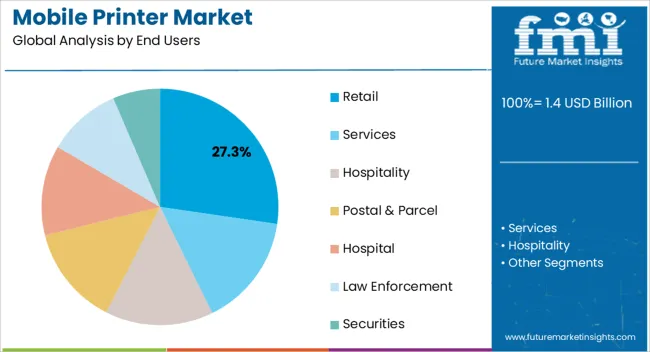
The retail segment is projected to hold 27.3% of the mobile printer market revenue share in 2025, making it the leading end user category. Its dominance is being reinforced by the growing need for efficient billing, labeling, and inventory management in fast-paced retail environments. Mobile printers are enabling retailers to reduce waiting times, improve checkout efficiency, and enhance the overall customer experience by supporting seamless point-of-sale transactions.
Their portability and ease of integration with retail management systems allow for quick deployment across large store formats as well as small outlets. Rising adoption of mobile payment solutions and the demand for instant receipts are further driving reliance on portable printing technologies.
Retailers are increasingly prioritizing devices that are cost-efficient, reliable, and capable of sustaining high-volume printing under demanding operational conditions With continued growth in organized retail and e-commerce, the ability of mobile printers to streamline workflows and provide flexibility across diverse retail formats is expected to secure the segment’s leading position in the market.
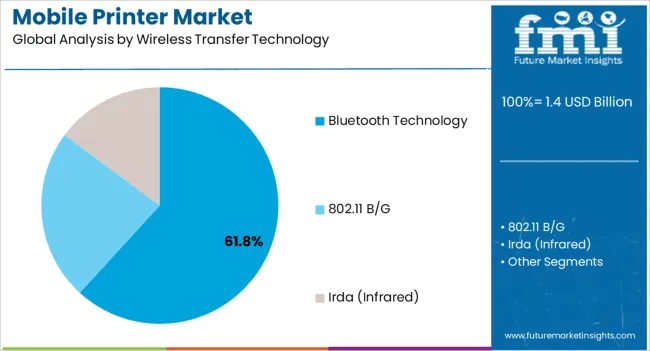
The Bluetooth technology segment is anticipated to account for 61.8% of the mobile printer market revenue share in 2025, establishing itself as the dominant wireless transfer technology. Its leadership is being driven by the widespread availability of Bluetooth-enabled smartphones and tablets, which makes pairing with mobile printers highly convenient. The technology provides a cost-effective and energy-efficient solution for short-range data transfer, reducing dependency on complex network setups.
Its ability to deliver secure and stable connectivity in retail, logistics, and field service applications has reinforced adoption across industries. Manufacturers are enhancing Bluetooth modules to support faster transfer rates and extended compatibility, ensuring seamless integration with diverse operating systems.
The segment is also benefiting from the growth of mobile payment systems and digital receipts, where instant and reliable connectivity is critical As demand for simple, flexible, and affordable wireless communication continues to increase, Bluetooth technology is expected to remain the preferred option, underpinning its leadership in the mobile printer market.
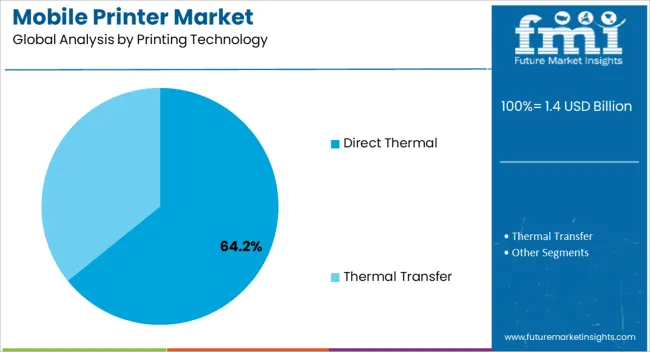
The direct thermal printing technology segment is expected to hold 64.2% of the mobile printer market revenue share in 2025, positioning it as the leading printing technology. Its strong market presence is attributed to low maintenance requirements, cost efficiency, and high-speed printing capabilities. Direct thermal printers do not require ink or toner, which significantly reduces operational costs and makes them highly suitable for high-volume applications such as receipts, tickets, and labels.
The technology delivers sharp, clear print quality with minimal mechanical components, enhancing device durability and reducing the likelihood of breakdowns in field environments. Businesses across retail, transportation, and logistics are adopting direct thermal printers to ensure consistent and efficient output under demanding operational conditions.
Their compact design and energy efficiency make them particularly well-suited for portable applications, where reliability and long battery life are critical With the growing emphasis on cost control and operational efficiency, direct thermal technology is expected to maintain its dominant position, supporting the wider adoption of mobile printing solutions globally.
Today the use of mobile devices in industries ranging from IT, health sector, retailers, hospitality, services and government had increased drastically and has changed the way they communicate, interact & work.
The demand for mobile printing has also grown at par with other mobile technologies. Mobile printing is the process to send data wirelessly from smartphone or tablet to the printer. The use of mobile printing facilitates the user to print where and when needed seamlessly.
Businesses which replace handwritten forms with mobile printers recite improvement in their workers’ productivity, accuracy and response to the customer needs which in turn produce revenue gains and expansion without adding labor.
Modern mobile printers implement tasks like barcode scanning and read RFID labels, printing receipts, invoices and tickets through a wireless network which can reduce number of hidden costs. Today mobile printers are light weight, durable and easy to use and offer good quality printing.
Many mobile printers come with Wi-Fi (IEEE 802.11) wireless interface which is most widely used which connects to LAN and offers multiple connections at faster speed and greater range. These days’ mobile printers come along with inbuilt credit/debit card readers to facilitate payments faster, easier & secure.
These printers also use short ranged Bluetooth Technology which offer one-to-one connection to receive commands from smartphones or tablet. The main benefit is once paired they can communicate each other at any point of time with improved security. Use of wireless technology instead of cables can also improve the ergonomics and improves reliability.
Thermal based technology is ideal for printing due to high quality print output and low maintenance of the equipment.
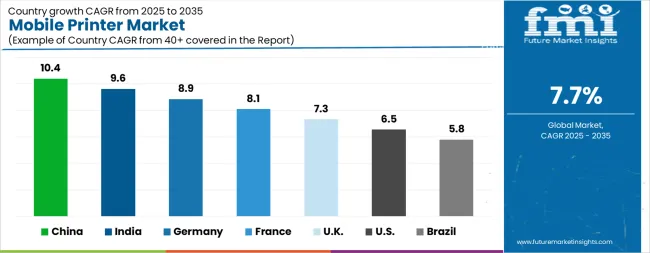
| Country | CAGR |
|---|---|
| China | 10.4% |
| India | 9.6% |
| Germany | 8.9% |
| France | 8.1% |
| UK | 7.3% |
| USA | 6.5% |
| Brazil | 5.8% |
The Mobile Printer Market is expected to register a CAGR of 7.7% during the forecast period, exhibiting varied country level momentum. China leads with the highest CAGR of 10.4%, followed by India at 9.6%. Developed markets such as Germany, France, and the UK continue to expand steadily, while the USA is likely to grow at consistent rates. Brazil posts the lowest CAGR at 5.8%, yet still underscores a broadly positive trajectory for the global Mobile Printer Market. In 2024, Germany held a dominant revenue in the Western Europe market and is expected to grow with a CAGR of 8.9%. The USA Mobile Printer Market is estimated to be valued at USD 501.1 million in 2025 and is anticipated to reach a valuation of USD 944.5 million by 2035. Sales are projected to rise at a CAGR of 6.5% over the forecast period between 2025 and 2035. While Japan and South Korea markets are estimated to be valued at USD 63.3 million and USD 35.8 million respectively in 2025.
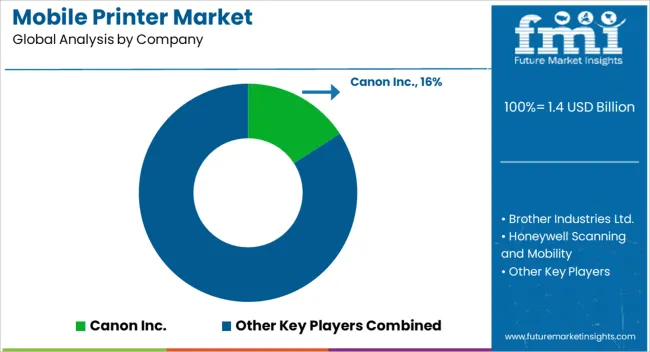
| Item | Value |
|---|---|
| Quantitative Units | USD 1.4 Billion |
| End Users | Retail, Services, Hospitality, Postal & Parcel, Hospital, Law Enforcement, and Securities |
| Wireless Transfer Technology | Bluetooth Technology, 802.11 B/G, and Irda (Infrared) |
| Printing Technology | Direct Thermal and Thermal Transfer |
| Regions Covered | North America, Europe, Asia-Pacific, Latin America, Middle East & Africa |
| Country Covered | United States, Canada, Germany, France, United Kingdom, China, Japan, India, Brazil, South Africa |
| Key Companies Profiled | Canon Inc., Brother Industries Ltd., Honeywell Scanning and Mobility, Hewlett-Packard, Toshiba Tec Corporation, Zebra Technologies, Seiko Epson Corporation, Polaroid Corporation, Star Micronics Co. Ltd., and Printek |
The global mobile printer market is estimated to be valued at USD 1.4 billion in 2025.
The market size for the mobile printer market is projected to reach USD 2.9 billion by 2035.
The mobile printer market is expected to grow at a 7.7% CAGR between 2025 and 2035.
The key product types in mobile printer market are retail, services, hospitality, postal & parcel, hospital, law enforcement and securities.
In terms of wireless transfer technology, bluetooth technology segment to command 61.8% share in the mobile printer market in 2025.






Our Research Products

The "Full Research Suite" delivers actionable market intel, deep dives on markets or technologies, so clients act faster, cut risk, and unlock growth.

The Leaderboard benchmarks and ranks top vendors, classifying them as Established Leaders, Leading Challengers, or Disruptors & Challengers.

Locates where complements amplify value and substitutes erode it, forecasting net impact by horizon

We deliver granular, decision-grade intel: market sizing, 5-year forecasts, pricing, adoption, usage, revenue, and operational KPIs—plus competitor tracking, regulation, and value chains—across 60 countries broadly.

Spot the shifts before they hit your P&L. We track inflection points, adoption curves, pricing moves, and ecosystem plays to show where demand is heading, why it is changing, and what to do next across high-growth markets and disruptive tech

Real-time reads of user behavior. We track shifting priorities, perceptions of today’s and next-gen services, and provider experience, then pace how fast tech moves from trial to adoption, blending buyer, consumer, and channel inputs with social signals (#WhySwitch, #UX).

Partner with our analyst team to build a custom report designed around your business priorities. From analysing market trends to assessing competitors or crafting bespoke datasets, we tailor insights to your needs.
Supplier Intelligence
Discovery & Profiling
Capacity & Footprint
Performance & Risk
Compliance & Governance
Commercial Readiness
Who Supplies Whom
Scorecards & Shortlists
Playbooks & Docs
Category Intelligence
Definition & Scope
Demand & Use Cases
Cost Drivers
Market Structure
Supply Chain Map
Trade & Policy
Operating Norms
Deliverables
Buyer Intelligence
Account Basics
Spend & Scope
Procurement Model
Vendor Requirements
Terms & Policies
Entry Strategy
Pain Points & Triggers
Outputs
Pricing Analysis
Benchmarks
Trends
Should-Cost
Indexation
Landed Cost
Commercial Terms
Deliverables
Brand Analysis
Positioning & Value Prop
Share & Presence
Customer Evidence
Go-to-Market
Digital & Reputation
Compliance & Trust
KPIs & Gaps
Outputs
Full Research Suite comprises of:
Market outlook & trends analysis
Interviews & case studies
Strategic recommendations
Vendor profiles & capabilities analysis
5-year forecasts
8 regions and 60+ country-level data splits
Market segment data splits
12 months of continuous data updates
DELIVERED AS:
PDF EXCEL ONLINE
Mobile Camping Toilet Market Size and Share Forecast Outlook 2025 to 2035
Mobile Phone Screen Underlayer Cushioning Material Market Size and Share Forecast Outlook 2025 to 2035
Mobile Application Store Market Size and Share Forecast Outlook 2025 to 2035
Mobile Money Market Forecast and Outlook 2025 to 2035
Mobile Application Testing Solution Market Size and Share Forecast Outlook 2025 to 2035
Mobile Cardiac Telemetry System Market Size and Share Forecast Outlook 2025 to 2035
Mobile Robots Market Size and Share Forecast Outlook 2025 to 2035
Mobile Crane Market Size and Share Forecast Outlook 2025 to 2035
Mobile Vascular Imaging Market Size and Share Forecast Outlook 2025 to 2035
Mobile Animal Inhalation Anesthesia Machine Market Size and Share Forecast Outlook 2025 to 2035
Mobile Unified Communications and Collaboration (UC&C) Solution Market Size and Share Forecast Outlook 2025 to 2035
Mobile Data Protection Market Size and Share Forecast Outlook 2025 to 2035
Mobile Medical Tablets Market Size and Share Forecast Outlook 2025 to 2035
Mobile WLAN Access Points Market Size and Share Forecast Outlook 2025 to 2035
Mobile Social Networks Market Size and Share Forecast Outlook 2025 to 2035
Mobile Application Development Platform Market Size and Share Forecast Outlook 2025 to 2035
Mobile Threat Management Security Software Market Size and Share Forecast Outlook 2025 to 2035
Mobile Broadband Infrastructure Market Size and Share Forecast Outlook 2025 to 2035
Mobile Enterprise Application Development Platform Market Size and Share Forecast Outlook 2025 to 2035
Mobile Analytics Market Size and Share Forecast Outlook 2025 to 2035

Thank you!
You will receive an email from our Business Development Manager. Please be sure to check your SPAM/JUNK folder too.
Chat With
MaRIA